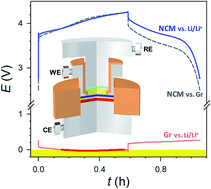Diagnosis of failure modes for all-solid-state Li-ion batteries enabled by three-electrode cells†
Abstract
Bulk-type all-solid-state Li-ion batteries have emerged as the enabler to achieve better safety and to use Li metal negative electrodes for higher energy density. However, all-solid-state half-cells fabricated using In or Li–In counter electrodes (CEs) have been routinely tested to assess working electrodes (WEs) without any verification. Moreover, there have been few reports on the in-depth analysis of all-solid-state full-cells, which is imperative for practical applications. In this work, for the first time, we report novel bulk-type all-solid-state three-electrode cells that enable successful deconvolution and diagnosis of the voltages of positive and negative electrodes even for cells having thin solid electrolyte (SE) layers. In the first case study, that of Sn/Li–In half-cells, earlier termination of Li–In CEs than Sn WEs, which results in unexpectedly low capacity, is measured. This problem is solved by percolating Li–In with SEs. For the second case, namely, that of LiNi0.6Co0.2Mn0.2O2/graphite full-cells having only 50–60 μm-thick SE layers (which are fabricated by a scalable wet-slurry process), internal short circuits by penetrating growth of Li metal during charging at high C-rates are revealed for the first time. Further, a unique dischargeability to 0 V for LiNi0.6Co0.2Mn0.2O2/graphite or LiNi0.6Co0.2Mn0.2O2/Si–C full-cells is described.



 Please wait while we load your content...
Please wait while we load your content...